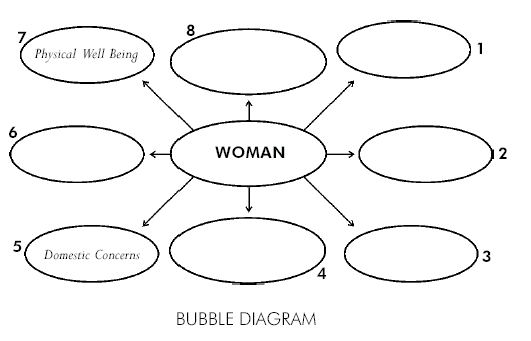Objective: a) To sensitise young readers, boys and girls, to the potent imagery in the magazine and become aware of its influences. b) To become aware of gender roles projected in the magazine and critically examine their impact and social relevance.
Aim of the Exercise: To create a portrait of the modern Indian woman as projected by the magazine and to examine this critically.
Age Level: 15 to 18 years
Duration: 4 sessions of 40 minutes each.
Material Required: Several issues of the magazine under study - Femina.
Preparation: Participants bring photographs of their family taken at home casually, while on a holiday, and during a formal occasion.
Activity One - 40 minutes
The participants are divided into groups of three and each group is given an issue of Femina with the following questions. They browse through the magazine and answer the questions.
- Give three phrases that convey your first impression.
- What do you find attractive in the magazine?
- What do you find yourself reacting to?
- Study specific features of the magazine's cover, its range of articles, features and advertisements, and identify the categories of persons who are the targeted readers of the magazine
- If you were to read this issue, which article would you read first and why?
Activity Two - 20 minutes
Scan the Contents page. Without using the terminology of the magazine, complete the following bubble diagram, depicting aspects of a woman's life that are highlighted by the magazine.
Aspects of a woman's magazine

Riffle through the magazine and number the bubbles in order of the space given to each area by the magazine.
Activity Three - 20 minutes
Pick out from the magazine phrases of advertisment copy, captions andblurbs that describe or refer to modern Indianwomanhood.
For example, 'looking good will give you a whole newoutlook on life', 'no dumb blonde'.
Try and find at least 10 such phrases.
Activity Four - 40 minutes
- Cut out and make a collection of pictures from the magazine that depicts people's 'lifestyles' and 'home living'.
- Study the display of photographs brought from home and compare and contrast the two sets of pictures. Note five observations from your comparative study.
Activity Five - 40 minutes or more
The above activities are the preparatory work for a structured discussion. The discussion should incorporate the participants' findings. Guiding questions for the discussion could be:
- Who are the persons that Femina sees as its readership? What background, income group, educational level and interests do they have? What are the kinds of products advertised in Femina?
- Is there a portrait of the Indian woman that Femina seems to build up through its contents? Are there different pictures of the 'younger woman' and the 'older woman'?What characteristics - of appearance, attitudes, interest - do the women projected in Femina appear to share?
- Do you know from your personal experience of family (and friends), people similar to the ones Femina is depicting? In what way are they similar and in what way different?
- (If a girl) Do some things in the portrait of the Indian woman appeal to you? What are they? How do your own concerns in life compare with the aspects of a woman's life that are projected in Femina? What similarities and differences do you see?
- (If a boy) Do some things in the portrait of the Indian woman appeal to you? What are they? And why do they appeal?
- What does the magazine's contents suggest about the relationship between women and men? How do you feel about this?
The discussion could aim at uncovering some of the motivations behind the various presentations in the magazine and, if possible, lead to an exploration of their own self-image and relationship with the opposite sex in the context of received media images.

